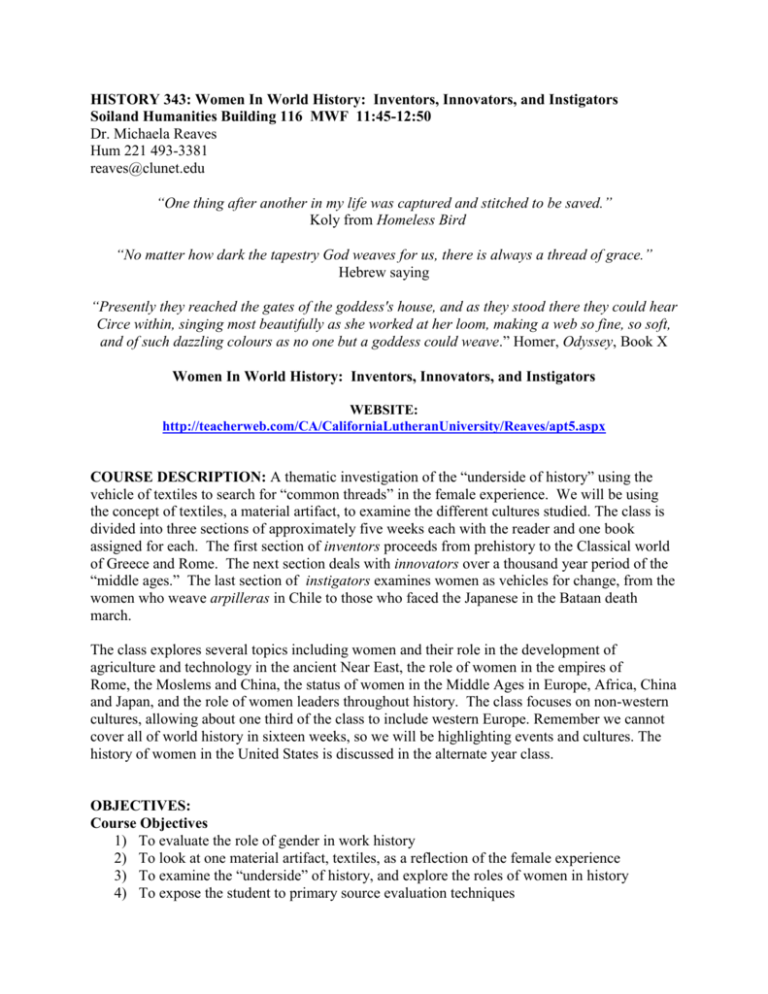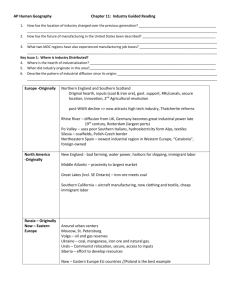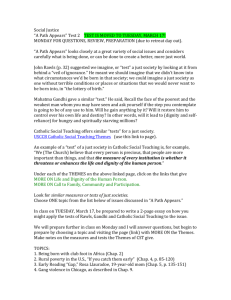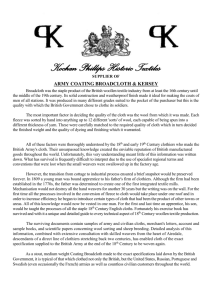HISTORY 343: Women In World History
advertisement

HISTORY 343: Women In World History: Inventors, Innovators, and Instigators Soiland Humanities Building 116 MWF 11:45-12:50 Dr. Michaela Reaves Hum 221 493-3381 reaves@clunet.edu “One thing after another in my life was captured and stitched to be saved.” Koly from Homeless Bird “No matter how dark the tapestry God weaves for us, there is always a thread of grace.” Hebrew saying “Presently they reached the gates of the goddess's house, and as they stood there they could hear Circe within, singing most beautifully as she worked at her loom, making a web so fine, so soft, and of such dazzling colours as no one but a goddess could weave.” Homer, Odyssey, Book X Women In World History: Inventors, Innovators, and Instigators WEBSITE: http://teacherweb.com/CA/CaliforniaLutheranUniversity/Reaves/apt5.aspx COURSE DESCRIPTION: A thematic investigation of the “underside of history” using the vehicle of textiles to search for “common threads” in the female experience. We will be using the concept of textiles, a material artifact, to examine the different cultures studied. The class is divided into three sections of approximately five weeks each with the reader and one book assigned for each. The first section of inventors proceeds from prehistory to the Classical world of Greece and Rome. The next section deals with innovators over a thousand year period of the “middle ages.” The last section of instigators examines women as vehicles for change, from the women who weave arpilleras in Chile to those who faced the Japanese in the Bataan death march. The class explores several topics including women and their role in the development of agriculture and technology in the ancient Near East, the role of women in the empires of Rome, the Moslems and China, the status of women in the Middle Ages in Europe, Africa, China and Japan, and the role of women leaders throughout history. The class focuses on non-western cultures, allowing about one third of the class to include western Europe. Remember we cannot cover all of world history in sixteen weeks, so we will be highlighting events and cultures. The history of women in the United States is discussed in the alternate year class. OBJECTIVES: Course Objectives 1) To evaluate the role of gender in work history 2) To look at one material artifact, textiles, as a reflection of the female experience 3) To examine the “underside” of history, and explore the roles of women in history 4) To expose the student to primary source evaluation techniques 5) To introduce the role of secondary source evaluation 6) To broaden the perception of history 7) To explore how to uncover information about women in history, particularly prehistory 8) To develop a sense of comfort for the student in giving presentations 9) To improve writing ability based on primary sources 10) To fulfill the Global Studies perspective The following CLU Educational Objectives are addressed in this course: Development of Critical thinking skills in Objectives 1, 2, 3, 4, and 7. Communication Skills in objectives 5 and 8 Written communication skills as reflected in the four analysis papers Information literacy Historical, cultural and global perspectives As outlined in the CLU History Departmental Goals, students who successfully complete this course will: Analyze and comprehend primary source texts Use periodization and chronology as organizing principles Demonstrate knowledge of major historical events and their significance EVALUATION: The grade in this class will be determined by your written work and your oral participation, as well as attendance and effort. There will be four 5-7 page analytical essays based on primary sources. There will also be a group presentation on one movie your group viewed. There will, of course, be two tests, a midterm and a final. These will consist of essays and identification. How to write the essay: what should you ask? Remember it all depends on primary source analysis! http://chnm.gmu.edu/wwh/essay/essay.php Essay #1 textiles 10% DUE 10/3 Essay #2 primary source 10% DUE 11/7 Essay #3 painting 10% DUE 12/12 Example: http://www-mcnair.berkeley.edu/ 98journal/ayeung/ Class presentation (movie) 10% DUE 12/8 Midterm 25% 10/24 Final 25% 12/15 Participation* 10% RUBRIC: All papers are strictly graded on several criteria. 1) English grammar, usage, and spelling 2) Research and documentation (Chicago style) 3) Reasoning and presentation of argument To earn an “A” a paper must have few, if any, errors in category one. In addition, each paper must have a minimum of five reputable sources. Finally, the clarity, assumptions, and critical thinking displayed in the paper are the final level of the grade. In other words, a flawless paper that does not fulfill the assignment or present a thorough and competent argument will not earn an “A”. *Participation is based not only on attendance, but contribution to the class and courtesy. Electronic equipment, e.g. cell phones, etc., in the classroom may have a negative impact on this portion of the grade. Attendance is required. Each student gets two “free” days to miss before the grade begins to drop. It also includes the class field trip on November 12, 2014 to the Getty Villa. Accommodations: California Lutheran University is committed to providing reasonable accommodations to students with various documented disabilities (physical, learning, or psychological). If you are a student requesting accommodations for this course, please contact your professor at the beginning of the semester and register with the Coordinator for Students with Disabilities (Pearson Library, Center for Academic Resources, Ext. 3260) for the facilitation and verification of need. Faculty will work closely together with you and your coordinator to provide necessary accommodations. TEXTS: Women In World History: Reading from World History, Vol. I and II. Sarah S. Hughes, 2002 Textiles: http://www.textilemuseum.org/commonthreads/ http://collectionsonline.lacma.org/mweb/about/cost_about.asp LACMA Primary texts on women: http://www.fordham.edu/halsall/women/womensbook.html Movies may change depending on availability. Diamont, The Red Tent, London: Picador, 1998. See, Snow Flower and the Secret Fan, NY: Random House, 2005. Gowda, Shipli Somaya, Secret Daughter, NY: William Morrow, 2010. http://www.cnn.com/WORLD/9711/16/india.women/ MOVIES for Assignments (not shown in class, on hold in the library): The Official Story (1985) about Argentina and the "disappeared" The Story of Women (1990) abortionist in Vichy France Paradise Road (1997) Bataan Death March In the Time of the Butterflies (2001) Trujillo rebellion Beyond Rangoon, (1995) Burma revolution Water, (2006) Women in India TOPICS: We have three primary topics,; women as inventors, innovators, and instigators. We will spend approximately five weeks on each. INVENTORS http://www.smith.edu/hsc/museum/ancient_inventions/hsclist.htm WEEK 1 September 3 Beginnings: The !Kung and Oetzi Film: Jared Diamond Reading: The !Kung (handout) http://www.ucc.uconn.edu/~epsadm03/kung.html Geography http://www.trussel.com/prehist/news276.htm ancient stone carvings http://www.primitiveways.com/paint_a_mammoth.html paint a mammoth Textile: Oetzi http://www.sintermeerten.nl/projecten/geschiedenis/projecten/Oetzi_en/%D6tzi2.htm WEEK 2: September 8 Bread, Beer and Brewing: Cultural Beginnings Film: Woman as Toolmaker Reading: Hughes, I, chap 1, pp. 9-26 http://www.owlnet.rice.edu/~reli205/andrew_beer/beer.html Biblical brew http://www.anchorbrewing.com/beers/ninkasi.htm how to brew http://www.brewingtechniques.com/library/backissues/issue2.5/hitchcock.html at home http://www.brewingtechniques.com/library/backissues/issue2.5/kavanagh.html beginnings of beer http://chnm.gmu.edu/worldhistorysources/d/250/whm.html case study on bowl WEEK3: September 15 Women’s Work: Footprints Film: Biblical Roots Textile: Joseph’s Technicolor Dreamcoat Genesis 37.3 Reading: Diamont Reading from Textiles http://www.abc.net.au/science/news/ancient/AncientRepublish_937424.htm lice http://www.unc.edu/courses/rometech/public/content/survival/Alison_Austin/spinning.html spinning http://www.unc.edu/courses/rometech/public/content/survival/Alison_Austin/dyeing.html dying http://www.unc.edu/courses/rometech/public/content/survival/DeRamus_Durham_Laxton/brian.html textiles WEEK 4: September 22 The Growth of City States: Egypt and the Fertile Crescent From Astarte to Nut Film: Pharaoh Women? Textile: http://www.digitalegypt.ucl.ac.uk/textil/index2.html Reading: Hughes, I. chap.5, pp. 27-45 FGM handout Scan through Jstor source. Copy and paste URL for article on Circumcision in Ancient Egypt at http://links.jstor.org/sici?sici=00211753%28200106%2992%3A2%3C317%3ACCORMS%3E2.0.CO%3B2-3 OR http://www.jstor.org/pss/3080631 http://donsmaps.com/ukrainevenus.html astarte figures http://www.trussel.com/prehist/news197.htm Venus hats http://www2.sptimes.com/Egypt/Galleries/Default.html Egyptian art http://www.womenintheancientworld.com/women%20in%20ancient%20egypt.htm http://www.womenintheancientworld.com/hammurabilawcode.htm WEEK 5: September 29 Women of Asia: Mulan, Nu Shu, the golden blossoms Film: Nu Shu Textile: The Weaving of a Dream For one version of the story see: http://www.aaronshep.com/books/MagicBrocade.html#general For samples of the type of art see silk brocade http://www.baronboutique.com/brocade.htm Reading: Hughes: I , chap.6, pp. 97-111. Essay #1 DUE on October 3 Warriors: http://www.lothene.demon.co.uk/others/womenprehist .html odd site.. http://www.scnf.org/history2.html http://www.koryubooks.com/library/wwj1.html China: http://www.chinavoc.com/history/tang/women.htm Documents: http://www.isop.ucla.edu/eas/documents/banzhao.htm INNOVATORS WEEK 6: October 6 The Classical World: Greece and Rome Textile: Arachne and Athena (copy on Eres) , Penelope Odyssey, Book II http://classics.mit.edu/Homer/odyssey.2.ii.html Reading: Hughes: I, ch. 5, pp. 79-96, chap. 7, pp. 113-128 http://www.indiana.edu/~anclife/welcome.html http://www.forumromanum.org/life/johnston_3.html Rome and marriage http://www.vroma.org/~bmcmanus/clothing2.html Roman clothing/women http://www.womenintheancientworld.com/women_in_ancient_rome.htm http://www.womenintheancientworld.com/women%20in%20ancient%20greece.htm WEEK 7: October 13 Women of the Near East Textile: “Clever Aneeat” Armenia " (Spring Season Carpet )ناتسراهب ىلاق Reading: Hughes II, chap. 2, pp. 33-50, I, Chap. 9, pp. 150-171 http://www.womenintheancientworld.com/women%20in%20isr ael.htm http://www.cjh.org/academic/women.html Jewish history site http://www.iranchamber.com/carpet/brief_history_persian_carp et.php Persian (Sassanid) carpets http://www.eruggallery.com/learnrugs/learn_hstry/lrn_hstry_rug s.htm Early rugs http://www.ucalgary.ca/applied_history/tutor/islam/learning/car pet.html Islamic World WEEK 8: October 20 Women in Africa MIDTERM October 24, 2014 Reading: Hughes, I, chap 11, pp, 189-205, FGM handout WEEK 9: October 27 Women of Africa: Textile: Kente cloth and Mbuti cloth Design your own: http://www.nmafa.si.edu/exhibits/kente/design2.htm Film: Becoming a Woman in Okrika, Reading: Hughes, I, chap. 12, pp. 207-226, II, chap. 6, pp. 113-136, II, chap. 8, pp. 161-181 Bark cloth: http://www.bampfa.berkeley.edu/exhibits/mbuti/worksheet.html#motifs Kente: http://art-smart.ci.manchester.ct.us/fiber-kente/kente.html WEEK 10: November 3 Essay #2 DUE November 7 Early Middle Ages : Pit and Pedestal 1000-1500 CE in Europe Textile: Bayeaux Tapestry http://www.bayeuxtapestry.org.uk/ Baldishol Tapestry http://www.aldus.dk/baldishol/default-eng.html Film: Hildegard http://library.thinkquest.org/12834/ The City of Women Reading: Hughes, I, chap. 8, pp. 129-149, witchcraft handout INSTIGATORS WEEK 11: November 10 FIELD TRIP by bus to Getty Villa leaves c. 4:45 pm India and the Silk Road Textile: Film: A Reputation: The Rape of Artemisia Gentileschi 30 minutes http://www.artemisia-gentileschi.com/index.shtml Reading: Hughes, I, chap. 3, pp. 47-62, II chap. 3, pp. 51-70 http://www.civilization.ca/cultur/inde/indtch8e.html Textiles of India http://www.endsoftheearth.co.uk/shop/ind&b-emb.htm Kantha WEEK 12: November 17 Middle Ages: Asia 1000-1500 Textile: Silk and Film: Small Happiness The Tale of the Genji 60 minutes Reading Day—Nov. 26, 2014: Hughes I, chap. 10, 173-188, II, chap. 1, 13-32 http://www.wsu.edu:8080/~dee/ANCJAPAN/WOMEN.HTM http://digital.library.upenn.edu/women/omori/court/court.html Lady Murasaki’s diary (3) http://www.wsu.edu:8080/~wldciv/world_civ_reader/world_civ_reader_2/kaibara.html essay WEEK 13: November 24 Women since 1500: Enlightenment and Romance Reading: Hughes, II, chap. 4, 71-88, handout http://chnm.gmu.edu/revolution/chap5a.html French Revolution http://www.ivcc.edu/gen2002/women_from_the_renaissance.htm Renaissance to Enlightenment http://www.wsu.edu/~dee/ENLIGHT/ENLIGHT.HTM European Enlightenment http://academic.brooklyn.cuny.edu/history/virtual/core4-5.htm overview http://home.att.net/~dawsonprof/bibliographyofromanticism.htm bibliography WEEK 14: December 1 Enlightened change Presentation week on movies Reading: II, chap. 7, pp. 140-159, chap., 9 and 10, pp. 1804-204 WEEK 15: December 8 FINAL PAPER DUE: December 12. Women in the 20th century: Textile: Arpillera, Hmong story clothes Dia’s Story Cloth Samples in class http://www.quiltethnic.com/hmong.html http://www.wisinfo.com/sheboyganpress/print/print_21538374.shtml http://www.womenfolk.com/quilting_history/hmong.htm http://www.civilization.ca/cultur/inde/indtch8e.html Resistance Film: Threads of Hope arpilleras Reading: Handouts, Hughes, II, pp. 205-254. http://www.aasianst.org/absts/1997abst/china/c132.htm Chinese feminism http://www.iisg.nl/~landsberger/iron.html Chinese advertising WEEK 16: December 15 Final examination: Monday December 1 10:30-12:30 Resources: http://dmoz.org/Society/People/Women/History/Ancient/ http://www.stoa.org/dio-bin/diobib?jstor Bibliography of ancient women WRITING PROMPTS Remember: submit ALL papers on TURNITIN: Class ID: 8495994 Password: reaves2014 PAPER #1 based on a material artifact prior to 500 CE DUE October 8 PROMPT: Find a sample of a textile, just one, and write a paper analyzing it as a piece of art and then its significance to the history of gender and women. 5 pages Start here: Be a Detective http://www.pbs.org/opb/historydetectives/techniques/textile.html http://www.pbs.org/opb/historydetectives/technique/textile-analysis/ Are you ready to research? Use this checklist as a starting point for your historical research project, and find out whether you've overlooked an important step in your approach. This list can also be used to evaluate the research systems and methods that you already use. Define the objective. A clear purpose gives structure to the investigation, and sets a course for the research to follow. Consider the end product. How you envision the final results will affect your decisions about materials and methods. Set limits. Use firm deadlines and budgets avoid overextending yourself. Understand the context. Before you investigate a subject, learn what life was like in the time and place where the history happened. Your main research will have more meaning. Know where to look. Create a list of potential resources. Ask yourself who else would have an interest in your research subject. Look on the Internet and in the local phonebook. Ask for resource suggestions. Add to the resources you've located on your own. Ask librarians and local experts for their recommendations. Get organized. Create a system for keeping your research material organized and accessible. Expect to need more storage space as your investigation progresses. Remember what you are doing. Use a logbook or diary to document every activity in your investigation. Don't rely on a good memory. Do it right. Put in the necessary effort. What comes out of your research project is a direct result of what you put into it. Consider the quality. The best and most reliable information always comes from primary sources. Only turn to secondary sources when it's absolutely necessary. Keep in touch. Create a complete list of every contact that you make during your research. Include a note that will help your remember why you thought this person was important. A sample of a paper from the above website regarding the shroud of Turin: Flury-Lemberg had originally been approached back in the early 1980s to try to date the Shroud by analyzing the structure of the cloth. She refused, "because," she says, "it is impossible to get a serious result dating a textile by textile analysis alone." In 1988, the keepers of the Shroud permitted radiocarbon dating of the relic -- with unanticipated results. The tests indicated that the cloth had been made sometime between 1260 and 1390 A.D., and thus was a medieval forgery rather than the actual burial shroud of Christ. And yet, when Flury-Lemberg finally did agree to head the restoration and conservation of the linen in the summer of 2002, the Shroud had a far different story to tell her. She first noticed that the entire cloth was crafted with a weave known as a three-to-one herringbone pattern. "This kind of weave was special in antiquity because it denoted an extraordinary quality," she says. (Less fine linens of the first century would have had a one-to-one herringbone pattern). That same pattern is present on a 12th century illustration that depicts Christ's funeral cloth, which, she says, is "extremely significant, because it shows that the painter was familiar with Christ's Shroud and that he recognized the indubitably exceptional nature of the weave of the cloth." Flury-Lemberg also discovered a peculiar stitching pattern in the seam of one long side of the Shroud, where a three-inch wide strip of the same original fabric was sewn onto a larger segment. The stitching pattern, which she says was the work of a professional, is surprisingly similar to the hem of a cloth found in the tombs of the Jewish fortress of Masada. The Masada cloth dates to between 40 B.C. and 73 A.D. The evidence, says Flury-Lemberg, is clear: "The linen cloth of the Shroud of Turin does not display any weaving or sewing techniques which would speak against its origin as a high quality product of the textile workers of the first century." PAPER #2 Primary source based 500-1500 CE DUE November 9 PROMPT: Pick one topic and research it carefully, e.g. female merchants in Flanders, witch trials in Germany, the role of nuns, etc. Pick the time period you like, find out if sources exist, and then ask the question. You will need FIVE primary sources, plus secondary sources. inimum 5 pages How to write the essay: what should you ask? Remember it all depends on primary source analysis! http://chnm.gmu.edu/wwh/essay/essay.php Start here: http://www.pbs.org/opb/historydetectives/technique/document-examination/ An excerpt from the website by Nancy Wingfield These women are all exceptional, in part because there are records that tell us about their lives and in part because they appear in world history textbooks. They all played important roles in economic, diplomatic, and political history and had formal or informal access to power. Traditionally, historical writing focused on elites and often rendered women invisible unless they were queens or empresses. With the socio-political changes of the late 1960s, historical inquiry expanded to include a focus on race, class, and gender. This literature has begun placing women’s varied experiences worldwide in historical context. Using gender to analyze the past has resulted in asking new questions about history and in reframing traditional areas of historical inquiry—economic, diplomatic, and political history. When we begin looking for women in history, they are there. And, they have long played important roles in all parts of their societies. The most famous women of history were less unusual for what they did than for having it recorded. Records from a time period that allow us to reconstruct the history of a person, place, or event are referred to as primary sources. Historians use many types of materials as primary sources for historical inquiry, including images, texts written for public and private use, materials and visual objects, and even music. All of these types of sources provide a window into the past, including the lives of women. PAPER #3 Primary source material artifact post 1500 DUE December 14 PROMPT: Choose a piece of visual art from history that portrays women from somewhere in the world. Then analyze what you learn from this depiction. Minimum 5 pages Start here: http://www.pbs.org/opb/historydetectives/technique/analyzing-art/ We will have a speaker give an example of this work and the site below gives a great example. Here is an example: http://www-mcnair.berkeley.edu/98journal/ayeung/ Sample by Amica O. Yeung (below) The 12th century Beijing handscroll Qingming Shanghe Tu (Spring Festival on the River) [Fig. 1, detail 1] is generally believed to have been painted during the Northern Song dynasty (c.a. 9071127) by the imperial court painter Zhang Zeduan. The Qingming scroll, highly celebrated ever since its creation, has been admired for its realistic artistic style and historical detail, and has been the subject of numerous studies throughout its long history. The emperors of the Ming (1368-1644) and Qing dynasties (16441911) especially admired the scroll, and commissioned artists to copy its style and composition. However, the exact origins of the Qingming scroll and the intentions of its creator have remained subjects of debate. Soon after the creation of the Qingming scroll, the Northern Song dynasty was invaded and overthrown by the Jin, a nomadic tribe. In the surviving historical record, the most nearly contemporaneous account of the Qingming scroll and its presumed creator, Zhang Zeduan, was written in 1186 by Zhang Zhu, the imperial court curator of the conquering Jin (Johnson 147). Considering the tumultuous end of the Song dynasty, and the scarcity of surviving records from that time, historians, art critics, and connoisseurs have since argued about the identity of the Qingming scroll's creator, the date and location of origin, the intended meaning of the work, and even whether or not the scroll is authentic. Here is a lesson plan to help you formulate questions: Interpreting art: http://www.womeninworldhistory.com/lesson9.html 1. What is happening in the image? 2. What civilization might it come from? 3. Approximately what time period was it made? 4. What snippet of information can be deduced about the role of women in the society from which it comes? ADDITIONAL INFORMATION Standards of Student Conduct Statements: The following are excerpts from the CLU’s student handbook, which can be found on the following link: http://www.callutheran.edu/student_life/student_handbook/ University Harassment Policy: For information on the University’s student harassment policy and rights, please go to the following link: http://www.callutheran.edu/student_employment/student_handbook.php. Pearson Library: Pearson Library provides access to scholarly books, journals, ebooks, and databases of full text articles from scholarly journals. To begin using these materials, visit the library web page http://www.callutheran.edu/iss/research/ . Librarians are available to assist you at the Thousand Oaks campus or via Meebo chat on the Library’s home page or emailing CLULibrary@callutheran.edu. You may contact the library at (805) 493-3250. For specific help in History ask for Lala Badal. CLU Writing Center: All enrolled CLU students are invited to make use of our services. For additional information, please visit http://www.callutheran.edu/writing_center/ , call 805-493-3257, book online at GenBook, or stop by the Writing Center (The Darling Collaboration Suite in the library) to schedule an appointment. CARNEGIE HOURS RATIONALE IS DELINEATED BELOW: Activity 4 unit course, 11 week semester InstructorLed W Course ee k L y Readings of required texts Weekly Classes 4 Weekly Course 3 45 2 2 15 30 2 30 Minimum, varies by student over fifteen weeks 1 Average, varies by student 1 Average, varies by student 60 Preparing oral presentation Primary source research Writing three papers Midterm Exam Preparation Final Exam Preparation SUM Independent Remarks Over fifteen weeks, uneven distribution Includes exams Average, varies by student 60 Minimum, varies by student 122 What is a Carnegie Hour? • • • Strictly time-based reference for measuring educational attainment used by American universities and colleges. Credit hour in this context is defined as an academic hour or 50 min. Credit unit equals one hour of instructor-led activities and two hours of independent work per week over 15 weeks. The Calculation: 1 unit = 1 instructor-led hour + 2 independent work hours per week based on 15 week semester so… 4 units= 4 instructor-led hours + 8 independent work hours per week on 15 week semester = 60 instructor-led hours + 120 independent work hours per semester






